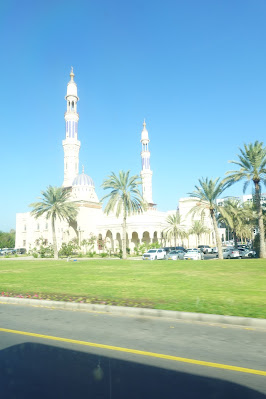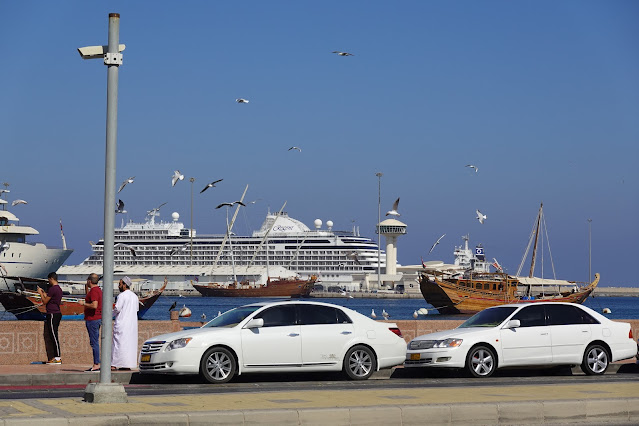 Let me start at the top, the rulers. The Middle East is largely a collection of monarchies, where one family runs the country. So who is at the top: king, sultan, sheikh, caliph, shah or emir? There are distinctions, and they've changed with time:
Let me start at the top, the rulers. The Middle East is largely a collection of monarchies, where one family runs the country. So who is at the top: king, sultan, sheikh, caliph, shah or emir? There are distinctions, and they've changed with time:
- Either Arabic or Islamic or Royal.
- Religion or politics.
- Highest religious and political authority: Caliph.
- The word means successor, or, in other words, successor to the Prophet Muhammad.
- A bit of history: Caliph ruled from who knows when to 1258 in Baghdad and 1517 in Egypt until Ottoman Sultans overcame.
- Then in 1924 Ataturk prevailed.
- Emir: a provincial delegate.
- A Sultan is the highest civil authority, such as in Oman and Brunei, or the equivalent in many countries, King. In other words, a Sultan is the King of an Islamic state.
- A Sheikh is the religious or political head of Muslims.
- To the right, Sheikh Zayed of UAE and Sultan Qaboos of Oman.
If that didn't confuse you, let me try to simplify, We've mostly spent the past week in the
United Arab Emirates, which has seven states or emirates. They are all run by Sheiks, but the Abu Dhabi sheikh is always president, and Dubai sheikh is the prime minister. To the left are current leaders Sheikh Mohamed bin Zayed Al Nahyan (right) of Abu Dhabi and Sultan Haitham bin Tariq of Oman.
Each sheikh is the successor to a previous one from the same family line, where succession follows a pattern similar to that of England.
We've spent two days in Oman, adjacent to the UAE. Oman has a Sultan, where power has been passed down through the male line. It is the oldest continuously independent state in the Arab World. The United Nations ranked Oman as the most improved nation in the world in terms of development during the preceding 40 years. Oman sets aside more on maintaining a military than any other country, 10% of their GDP, versus only 2.2% for Saudi Arabia and
3.3% for the USA,...which
spends more on war than the next the next nine countries, combined.
Today, we took the Mystical Muscat tour. Unexpectedly for me, I was expecting a slightly run-down society with minimal infrastructure. What a surprise, as much of what I saw was sparkingly new. It is the capital and most populated city in Oman, with 1.4 million (same as Hawaii), roughly half expatriates. Led by Sultan Haitham bin Tariq Al Said.
While Polynesians first settled in
Hawaii around 400 AD, communal activity in
Muscat dates back to 6000 BC, although the official city only formed around 1200 AD. It's history since then involved the Portuguese, Ottoman Turks and British, although the USA dropped in to talk in the mid-1850's.
You don't want to come here in July and August, for the average high temperature exceeds 120 F. However, the average low remains below70 F from November through March. Rains 4 inches/year.
On those notes, our Mystical tour of Muscat is shown below, beginning with the Sultan Quaboos Grand Mosque, the largest in Oman. Completed only in 2001, it was subsequently overwhelmed by that grand mosque in Abu Dhabi. Thus, the stop was, in comparison, pale. But, here are a few photos.
Our guide showed what they have to do before entering the prayer room. You need to carefully wash your hands and face, including nose and ears three times each, plus feet, then swallowing, gurgling and spitting out water, three times.
Next a stop at their bazaar, which is across the bay from our ship:
As usual, I bought nothing. Next, we visited their national museum.
It was a worthy tour, and better than yesterday's, and much more so than the day before. Maybe that's progress.
We also continued eating. White Asparagus ala Vienna, blue cheese soufflé and scallops.
This morning before our Muscat tour, we had a caviar/champagne breakfast, at sunrise.
So goodbye to Muscat, and on to Mumbai.
-
 Let me start at the top, the rulers. The Middle East is largely a collection of monarchies, where one family runs the country. So who is at the top: king, sultan, sheikh, caliph, shah or emir? There are distinctions, and they've changed with time:
Let me start at the top, the rulers. The Middle East is largely a collection of monarchies, where one family runs the country. So who is at the top: king, sultan, sheikh, caliph, shah or emir? There are distinctions, and they've changed with time:


























Comments
Post a Comment